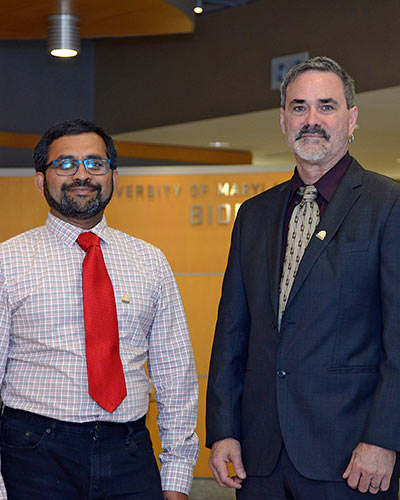May 13, 2016

Roving DNA Strands Could Play Key Role in Some Colon Tumors, Perhaps Other Tumors Too
For more than 50 years, scientists have known of the existence of “jumping genes,” strands of DNA material that can move from one location in the genome to another.
Now, for the first time, researchers at the University of Maryland School of Medicine (UM SOM) have demonstrated conclusively that one of these jumping genes appears to play a key role in the generation of cancer. The study was published today in the journal Genome Research. It is the first study to ever elucidate this process.
“This is really a new way to understand how tumors grow,” said the study’s senior author, Scott E. Devine, PhD, associate professor of medicine at the Institute for Genome Sciences at the University of Maryland School of Medicine. “We think it could explain a lot about the mutation process that underlies at least some cancers.”
Jumping genes are also known as transposable elements. Dr. Devine and his colleagues focused on one of these elements known as LINE-1, or L1. Until about 25 years ago, researchers thought that L1 had no effect on the genome. But since then, several studies have found that it is active in both the brain and in the body. One study, for example, has found that it plays a role in some cases of hemophilia.
In recent years, scientists have found associations between L1 and cancer. But no study had found a clear link. Devine and his colleagues suspected that L1 might trigger cancer by causing mutations in other genes that suppress cancer. They focused on a tumor suppressor gene known as APC. This gene is mutated in about 85 percent of colon cancer cases.
The researchers screened tumors from 10 patients, looking for L1 insertions at the APC gene. In one patient, they found evidence of this insertion. They further investigated samples from this patient, and found more evidence that L1 had played a role. In all, they found 27 L1 insertions in the tumor – insertions that were not found in surrounding healthy tissue. They also found evidence that L1 was responsible for inactivating the APC gene. Such silencing may allow tumors to grow unimpeded, Devine says.
Devine notes that the patient whose tumor showed evidence of L1 involvement had a strong family history of cancer. It may be that certain groups or families are more prone to L1-related cancers, he says.
The study also included UM SOM researchers Emma C. Scott and Eugene J. Gardner, as well as scientists from Emory University in Atlanta.
“Transposable elements are increasingly being recognized as an active player in a wide range of physiological processes,” said UM SOM Dean E. Albert Reece, MD, PhD, MBA, who is also the vice president for Medical Affairs, University of Maryland, and the John Z. and Akiko K. Bowers Distinguished Professor. “It’s exciting to see that researchers from the School of Medicine are involved in opening up new discoveries in this fertile subject area, especially because this domain has the potential to eventually help millions of patients.”
About the Institute for Genome Sciences
The Institute for Genome Sciences, founded in 2007, is an international research center within the University of Maryland School of Medicine. Comprised of an interdisciplinary, multidepartment team of investigators, the Institute uses the powerful tools of genomics and bioinformatics to understand genome function in health and disease, to study molecular and cellular networks in a variety of model systems, and to generate data and bioinformatics resources of value to the international scientific community.
igs.umaryland.edu
About the University of Maryland School of Medicine
The University of Maryland School of Medicine was chartered in 1807 and is the first public medical school in the United States and continues today as an innovative leader in accelerating innovation and discovery in medicine. The School of Medicine is the founding school of the University of Maryland and is an integral part of the 11-campus University System of Maryland. Located on the University of Maryland’s Baltimore campus, the School of Medicine works closely with the University of Maryland Medical Center and Medical System to provide a research-intensive, academic and clinically based education. With 43 academic departments, centers and institutes and a faculty of more than 3,000 physicians and research scientists plus more than $400 million in extramural funding, the School is regarded as one of the leading biomedical research institutions in the U.S. with top-tier faculty and programs in cancer, brain science, surgery and transplantation, trauma and emergency medicine, vaccine development and human genomics, among other centers of excellence. The School is not only concerned with the health of the citizens of Maryland and the nation, but also has a global presence, with research and treatment facilities in more than 35 countries around the world.
http://medschool.umaryland.edu/
Contact
Office of Public Affairs
655 West Baltimore Street
Bressler Research Building 14-002
Baltimore, Maryland 21201-1559
Contact Media Relations
(410) 706-5260
Related stories

Tuesday, September 14, 2021
University of Maryland Medicine Partners with Vibrent Health to Embark on Landmark Precision Health Research Study
University of Maryland Medicine announced a new partnership today with Vibrent Health, a health technology company based in Fairfax, Virginia, to create the All of Maryland Precision Health Initiative, a statewide digital platform for studies examining how genes and other factors affect health. The mission of All of Maryland -- a study that will be led by University of Maryland School of Medicine (UMSOM) researchers -- is to discover better ways to individualize healthcare. The goal is to enable individuals to benefit from treatments tailored to their own health profiles.

Thursday, February 25, 2021
UM School of Medicine Researchers Participate in Landmark Study Detailing Sequencing of Full Human Genomes to Better Capture Genetic Diversity
Researchers at the University of Maryland School of Medicine (UMSOM) co-authored a study, published today in the journal Science, that details the sequencing of 64 full human genomes. This reference data includes individuals from around the world and better captures the genetic diversity of the human species. Among other applications, the work will enable population-specific studies on genetic predispositions to human diseases as well as the discovery of more complex forms of genetic variation.

Friday, September 29, 2017
University of Maryland School of Medicine Researchers Identify Millions of New Genes From Bacteria Living on and in the Human Body
A new study of the human microbiome—the trillions of microbial organisms that live on and within our bodies—has uncovered millions of previously unknown genes from microbial communities in the human gut, skin, mouth, and vaginal microbiome, allowing for new insights into the role these microbes play in human health and disease.
